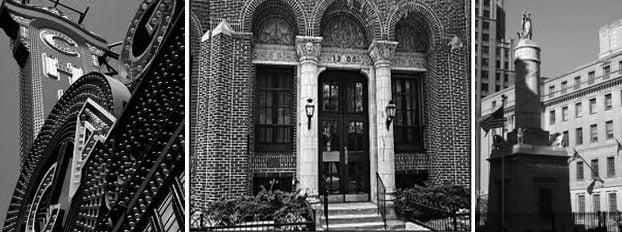
Marshall Holleb
He may be the most influential
Chicagoan you've never heard of. Marshall Holleb helped shape the landscape
of modern Chicago. As an attorney and real estate developer, he is credited
with saving the Chicago Theater, the Arts Club, and Montgomery Ward's first
warehouse. He was also instrumental in founding the Museum of Contemporary
Art, and in the development of Illinois Center, an innovative project that
occupies air space over the Illinois Central Railroad tracks.
One of Marshall Holleb's great skills has been to surround himself with
like-minded and influential people who could help bring his dreams to reality.
He started his own first law practice with brother-in-law Sidney Yates;
by working behind the scenes in Chicago and national politics, he has forged
alliances that have supported projects in development and in historic preservation.
And through it all, by his side has been his life partner of 57 years,
his wife Doris Holleb.
Read on, and follow the links, for the stories of some of Marshall Holleb's
greatest projects, and for a bio of his equally fascinating and effective
life partner, Doris Holleb.
Chicago Theater Story
One of Marshall Holleb's most significant preservation projects was to
help save the landmark Chicago Theater on State Street in the Chicago Loop.
The great Chicago Theater opened in 1921. It was the first Loop theater
built by the Balaban & Katz Company, a major regional theater chain. The
construction costs were nearly double those of nearby State-Lake, built
at about the same time. Graced with marble columns, glass chandeliers,
and a red-carpeted stairway, the theater seated 5,000, for moving pictures
as well as live stage events. The magnificent entertainment palace enjoyed
a decades-long heyday before falling into disrepair by the 1960s.
In the 1950s, lawsuits by competing theaters brought an end a practice
that benefited the Chicago and other Loop theaters - that of releasing
new movies in Loop theaters first, then neighborhood theaters a few weeks
later. Television also began to cut into entertainment revenues. But "white
flight" to the suburbs, and the general decline of the Loop's popularity,
very nearly sounded the death knell for the once-elegant theater.
Hoping to stave off the threatening failure of the theater, Balaban and
Katz remodeled the Chicago in the 1950s, replacing or covering up its more
ornate architectural features with new lighting fixtures and false ceilings.
Their efforts to save the business didn't work, and the theater was sold.
During the 1970s, under the ownership of Plitt Theaters, the Chicago gradually
adapted to the city's changing demographics. More and more African-American
and Latino residents began to frequent Loop retail and entertainment establishments.
Eager to keep their theaters open and profitable, Plitt willingly catered
to their newfound patrons in their movie offerings. However, the city eventually
had much of the downtown theater district, including the Chicago, designated
a "blighted" area subject to government-backed redevelopment. According
to plans, the city would buy the theater from Plitt, bulldoze it and several
other nearby theaters and retail establishments, and subsidize the construction
of new office towers on the cleared land. The last movie at the Chicago
was shown on September 10, 1985.
Marshall Holleb was instrumental in the move to preserve the theater, rescuing
it only weeks before its scheduled demolition. In 1986, with the financial
assistance of the city, Plitt sold the Chicago to Holleb's group of preservationists,
who oversaw a nine-month, multi-million restoration of the historic theater.
Since its restoration, the theater has hosted Broadway musicals, concerts,
comedians, and other live performances. The familiar vertical sign is once
again the beacon of great entertainment in a setting of style and elegance.
The Museum of Contemporary Art
Another of Marshall Holleb's many projects involving city arts and architecture
was his role in the establishment of the Museum of Contemporary Art. Established
in 1967, the MCA opens its doors to the public in a newly renovated one-story
building on Ontario Street that had originally been built as a bakery.
In 1977, on its tenth anniversary, the MCA began raising funds to purchase
the adjacent three-story townhouse to expand the museum.
In 1993, ground was broken for the new museum building, on the former site
of the National Guard Armory. The Ontario Street building closed in February
of 1996. In June, the MCA's new building and sculpture garden opened with
a celebration attended by 25,000 visitors.
The Museum has brought the brightest lights of contemporary arts to Chicago.
In the vast array of media ranging from performance art to painting to
music to sculpture to photography, the Museum has featured the work of
new discoveries and world-famous artists. The list is impressive. To name
but a few: Christo, Claes Oldenburg, Frida Kahlo, Nancy Spero, Robert Mapplethorpe,
Robert Rauschenberg, John Cage, Cindy Sherman, Chuck Close, Roy Lichtenstein,
Robert Heinecken.
And if you are tantalized by the list, check out the Museum
of Contemporary Art website for more!
Holleb Behind the Scenes in Politics
Marshall Holleb's career brought him into contact with many a well-known
politician, as his scrapbooks attest. One of his great behind-the-scenes
roles involved the 1952 presidential candidacy of Adlai Stevenson.
Holleb and others who supported the candidate convinced him to run in an
uphill race against Dwight Eisenhower.
Despite his failure to reach the White House, Stevenson was a brilliant
and influential politician. His biography provides
an inspiring read.
Marshall Holleb the Jock
At 84 and in vibrant health, Marshall Holleb sets an example in more ways
than one for those of us who aspire to a long and healthy life. He was
an active athlete in high school and college, and has been a lifelong self-proclaimed
jock. Among Holleb's public service works, he has been active with the
Illinois Council on Aging.
Marshall Holleb the Family Man
Along with forming close friendships and working relationships with prominent
Chicagoans, Marshall Holleb has made a life-long commitment to one of the
most influential Chicago women, his wife, Doris Holleb. Doris Holleb, a
University of Chicago professor, economist and urban planner was one of
the first women to attend the Harvard Graduate School of Economics. Read
more in her brief biography.
And now for something completely different
Marshall Holleb's involvement with the art world took an interesting twist
in his professional encounter with the famed art forger known as Elmyr
De Hory. This audacious artist collaborated with Orson Welles to make a
film called F for Fake (1973).
For more of
the story, visit the website! But is it the authentic website, or the fake?

Your $40 Gift Membership will include:
|
























































